
THE government and people of Taiwan invested in the government and people of St. Lucia through ICT in our Education System. It means therefore, that they have provided the money and confidence which is needed to boost St. Lucia’s Education System and give it a chance to grow.
The Taiwanese Ambassador, Peter Chen, is providing all the ‘energy’ that is needed to ensure that ICT takes “root’ in our Fair Helen.
But what exactly is ICT and how important is it to our education system? ICT means Information and Communication Technology. And the technology is a mode of education that use information to support, enhance, and optimise the delivery of information and instruction. By optimise I mean to achieve more in a shorter space of time.
Now Information and Communication Technology (ICT) can rapidly improve student learning when teachers are digitally literate and understand how to integrate it into the school curriculum. Schools use a diverse set of ICT tools to communicate, create, disseminate, store and manage information.
Indeed, some ICT tools are: computers, laptops, scanners, software programmes, data projectors, and other interactive teaching devices. Those devices allow the teacher or facilitators of learning through student-to-teacher, and student-to-student interaction
But most importantly it allows for much student engagement. Now student engagement is principle which is discussed very widely in education, or teaching and learning. Student engagement refers to the degree of attention, curiosity, interest, optimism and passion that students show when they are learning or being taught. The degree of student engagement leads to a level of motivation which helps students to make steady progress in their work.
Now the Taiwanese Ambassador, working in collaboration with the Ministry of Education has set up a few smart classrooms. There is the intention to provide every school with a smart classroom.
But what is a Smart Classroom? A Smart classroom includes teacher lead learning spaces that include a computer, interactive whiteboards and many of the devices already mentioned in this article. Like the traditional classroom, the teacher delivers instruction from the front of the class but the smart devices allow the student more opportunities to interact with the content of the lesson, the teacher and each other.
I need to tell you that the television is an audio/visual device with much capabilities for teaching and learning. And the projector follows very closely.
I want parents and teachers to understand that it’s not the amount of devices that are located in the classroom, but has to do more with how the classroom teacher uses the tools or devices at his or her disposal.
And that is why teacher training in the use of the emerging technologies is so very important. Indeed, many of our classroom teachers are familiar with those emerging technologies and how they are used. But the rapid turnover of teaching staff may threaten the functioning of effective smart classrooms.
I can tell you, that many of our students entering our primary schools even with having gone to pre-school, can use the television, computer quite well. They learn a lot from homes with some of those devices. A kindergarten student may surprise you with the skills he or she has acquired from home. And they may even be able to use the technological language that go with the devices. Indeed, that is an asset for the class teacher or facilitator of learning.
As I have often said in my Open School Lessons, parents want their children to learn. The children themselves want to learn. And if the teacher or facilitators of learning can detect the students learning style together with the use of modern day devices or technologies, well that’s ‘fertile ground’ for rapid progress and improved performance of students.
At this point it is important to indicate, that the use of modern-day technologies does not remove or negate instructional planning. In fact, the need for detailed planning has become more critical in the Smart Classroom. The work of the teacher or facilitator of learning will become more intense and focussed. And the reward would be more progress and improved performance for the student, the class and the school as a whole.
When the students are tested, and the results are released, all the stake-holders come into focus: students, teachers, parents and principals, Ministry of Education officials, sponsors such as the Taiwanese government, all sing their praises.
Over the years, the Taiwanese government has assisted the government and people of St. Lucia in several areas of economic and social importance. And we have to applaud them for that assistance.
Technical missions from Taiwan have come to St. Lucia on several occasions to observe, assess and evaluate what we are doing in education, industry and agriculture, to name a few areas. Many students have travelled to Taiwan where they receive training in one area or another. As I write, many St. Lucians are in Taiwan undergoing training in various areas.
At this point, as a St. Lucian citizen, an educator; someone who has spent close to five decades in our education system, I want to thank the Taiwanese government and people, through Ambassador Peter for the proposed smart classrooms and other areas in which they have provided assistance to government and people of St. Lucia.
We are now coming close to the end of the first term in the Academic year 2022/2023. There is still much to be achieved in our education system between now and the end of the academic or school year.
I pray for the strength, resilience and passion of our teachers in St. Lucia who are able to prove themselves when it becomes necessary to reflect that. And I know their students are appreciative as well.
May God bless the Helen of the West!












